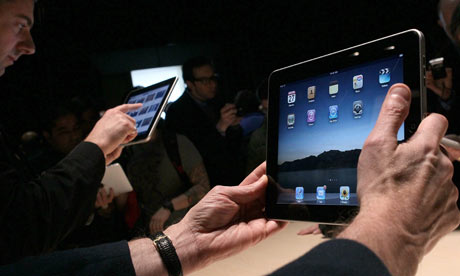


Apple iPad: the first review
You may wonder what the Apple iPad is for. The answer: everything, but could that be too much?

Apple iPad is finally shown off. Photograph: Justin Sullivan/Getty Images
Like everything Apple designs, the iPad is intended to satisfy our cravings for simplicity and clarity. Steve Jobs had already sneered at the idea of netbooks, labelling the cheap, low-powered laptops that have proved phenomenally popular with consumers slow and clunky – but it's clear that this is the market the iPad is aiming for.
On the surface it appears to be little more than an oversized iPhone, a flat, black screen with a single button but underneath it wants to be a laptop.
As one of a small group of people given a sneak, hands-on preview of the iPad, my first impressions were good: it's hefty but not heavy, feeling solid and responsive in the hand. The screen is about the size of a large paperback, but it's just half an inch deep. That big, glassy screen does leave it vulnerable to breakages, but could also prove liberating for people who are used to toting a laptop around with them.
Using it will be familiar to anybody who has tried an iPhone: it uses the same combination of swipes, pokes, jabs and sweeps of the finger of its smaller cousin. Sweep your hand across its reactive 9.7-inch screen, though, and everything feels more satisfying and natural.
The big problem I had was in trying to understand what the iPad was for: the answer, it seems, is everything.
It attempts to do almost everything that your laptop can, while also offering almost everything your smartphone can do as well. Surfing the web was a breeze, while it plays video smoothly and handles a variety of games pretty well. You can use any of the existing iPhone applications straight away, though it is disappointing when you realise that they become blocky and almost childlike when expanded to fill the larger screen.
Switched into ebook mode, the way the iPad emulates the printed page feels fairly natural, if not entirely on a par with rival ebook readers such as Amazon's Kindle. The backlit screen doesn't come anywhere near the clarity of electronic ink, which means it's going to prove a lot harder on the eyes of bookworms(it's great for reading in bed, one Apple flunky told me, keen to stress the positive side). But what it loses here, it makes up for with the addition of colour and even video. When you get down to business, the iPad might not be enough for heavy users. The on-screen keyboard will take a little getting used to: unlike the thumb-driven flash of text messaging, typing on the iPad requires either a single finger stab or putting it down on a flat surface. But for casual entertainment, it manages to do plenty very well: the sort of thing likely to tempt customers who want a lightweight laptop but doesn't really need it to do any heavy lifting.
For anyone who loves new technology, getting the first touch of a new Apple device is a little like laying hands on the Shroud of Turin, or seeing a unicorn: the first experience of a mythical object imbued with miraculous properties.
Jobs trumpeted it as exactly that, a magical device that will change the way we use computers in our everyday lives. And while playing with the iPad was not exactly a religious experience, it's not hard to see that the gadget, or at least the ideas it contains, will be with us for a long time to come.
NS//roaming
